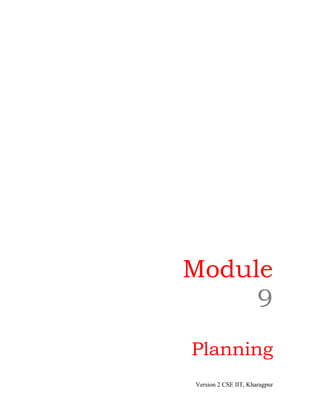The document discusses planning and logic-based planning. It covers:
1. The formulation of planning problems and differences between planning and problem solving.
2. Representing planning problems using STRIPS and situation calculus.
3. Planning algorithms like situation space planning and plan space planning.
4. Issues with full commitment planning and the need for least commitment planning.
The goal is to teach students how to represent planning problems logically and solve them using suitable planning algorithms.








![" a,s Have(Milk,Result(a,s)) <=> [(a = Buy(milk) / At(supermarket,s)
/ (Have(Milk,s) / a NOT= Drop(Milk))]
Result(a,s) names the situation resulting from being in s while executing action a.
It will be useful to handle action sequences than just a single action. We can use Result'
(l,s) to mean the situation resulting from executing l (the sequence of actions) beginning
in s. Result' is described by saying that an empty sequence of actions will not effect the
situation, and a non-empty sequence of actions is the same as doing the first action and
then finishing the rest of the actions from the resulting situation.
Empty sequence of actions is represented as:
" s Result' ([],s) = s
Non-empty sequence of actions is represented as:
" a,p,s Result' ([a|p],s) = Result' (p, Result(a,s))
p is a plan and when applied to start state So, develops a situation which satisfies the goal
query.
p could be:
At(home, Result' (p,So)) / Have(Milk, Result' (p,So)) / Have(Bananas, Result'
(p,So)) / Have(Drill,Result' (p,So))
The goal query could be:
G = [Go(Supermarket), Buy(Milk), Buy(Banana), Go(Hardware Store),
Buy(Drill), Go(Home)]
In theory, there isn't much more to say. Doing planning this way doesn't guarantee a
practical solution. Plan p guarantees to achieve the goal but not necessarily efficiently.
This approach is representation strong, but reasoning weak because of the poor efficiency
of resolution.
Practical Planning:
To make planning practical we need to do 2 things:
1. Restrict the language with which we define problems. With a restrictive language,
there are fewer possible solutions to search through.
Use a special-purpose algorithm called a planner rather than a general-purpose theorem
prover to search for a solution.
Version 2 CSE IIT, Kharagpur](https://image.slidesharecdn.com/lesson22-111110110403-phpapp02/85/Lesson-22-9-320.jpg)